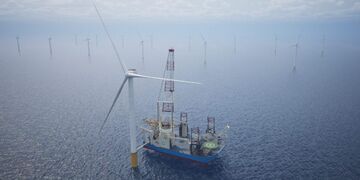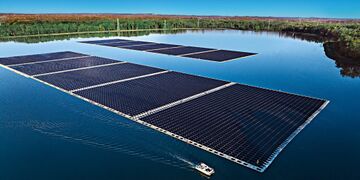Antilles
This article is a work-in-progress because it is incomplete and pending further input from an author. Note: The contents of this article are not considered canonical and may be inaccurate. Please comment on this article's talk page to share your input, comments and questions. |
Script error: The module returned a nil value. It is supposed to return an export table.
Antilles | |
|---|---|
Overseas territory of Burgundie | |
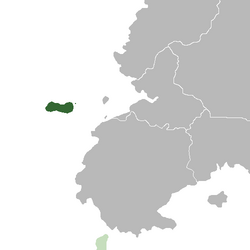 Location of the Burgoignesc province of Antilles (dark green) Off the coast of Audonia (gray) Alcairet (light green) | |
| Acquired for Medimeria | 2014 |
| Capital City | Cruxendale |
| Area | |
| • Total | 9,530.00 sq mi (24,682.59 km2) |
| Population (2020) | |
| • Total | 1,207,204 |
| • Density | 126.7/sq mi (48.91/km2) |
Antilles is an overseas possession of the Burgundie, located off the northern coast of Audonia. It was previously owned by Urcea. As of 2010, the population of the island was slightly less than 800,000, representing a major growth since 2000, in large part due to being a major waystation between Urcea and its possessions in Crona, namely New Harren. Much of the economy of Antilles is devoted to oceangoing activities, and besides its well known position as a Urcean military base, it is a popular destination for Levantine cruise lines. Fishing is also a large industry in Antilles. In 2014, it was exchanged with Burgundie for the island of Medimeria.
Etymology
Antillia was a fabled land far to the east of Levantia written about during antiquity; the name was applied to the Crusader state established in the area.
Geography
Antilles is a low lying coastal plain with no major elevation features over 459m above sea-level. The interior is rolling hills and there are some steep coastal cliffs, especially in the south. It is bound by the Sea of Istroya in the west and north, the Koushahr Bay in the south and east.
Climate
Antilles has a Aw: Tropical Wet-And-Dry climate. The province has two types of climate. The first, which occurs in the northern and southern extremities and the entire western coast, has two distinct seasons – six months dry and six months wet. The other, which prevails in the eastern coast, has a short dry season of one to three months and no pronounced rainy period during the rest of the year. The southern part of the province is virtually free from tropical depressions but northern Antilles experiences torrential rains during the months of July and August. Summer months serve as peak season for Antilles. Sea voyages are most favorable from March to early June when the seas are calm. The average maximum temperature is 31 °C (88 °F) with little variation all year.
| Climate data for Cruxendale (1981-2010) | |||||||||||||
|---|---|---|---|---|---|---|---|---|---|---|---|---|---|
| Month | Jan | Feb | Mar | Apr | May | Jun | Jul | Aug | Sep | Oct | Nov | Dec | Year |
| Record high °C (°F) | 34.4 (93.9) |
34.6 (94.3) |
36.4 (97.5) |
36.3 (97.3) |
36.0 (96.8) |
35.6 (96.1) |
35.2 (95.4) |
35.2 (95.4) |
35.2 (95.4) |
36.0 (96.8) |
34.3 (93.7) |
34.0 (93.2) |
36.4 (97.5) |
| Average high °C (°F) | 30.9 (87.6) |
31.1 (88.0) |
31.9 (89.4) |
32.9 (91.2) |
32.9 (91.2) |
32.1 (89.8) |
31.5 (88.7) |
31.6 (88.9) |
31.7 (89.1) |
31.6 (88.9) |
31.4 (88.5) |
31.0 (87.8) |
31.7 (89.1) |
| Daily mean °C (°F) | 27.3 (81.1) |
27.4 (81.3) |
28.1 (82.6) |
28.9 (84.0) |
29.1 (84.4) |
28.4 (83.1) |
28.0 (82.4) |
28.0 (82.4) |
28.0 (82.4) |
27.9 (82.2) |
27.9 (82.2) |
27.7 (81.9) |
28.1 (82.6) |
| Average low °C (°F) | 23.8 (74.8) |
23.7 (74.7) |
24.3 (75.7) |
25.0 (77.0) |
25.3 (77.5) |
24.8 (76.6) |
24.4 (75.9) |
24.3 (75.7) |
24.3 (75.7) |
24.2 (75.6) |
24.4 (75.9) |
24.3 (75.7) |
24.4 (75.9) |
| Record low °C (°F) | 18.3 (64.9) |
18.5 (65.3) |
19.2 (66.6) |
20.9 (69.6) |
21.3 (70.3) |
16.2 (61.2) |
20.6 (69.1) |
20.5 (68.9) |
20.6 (69.1) |
20.9 (69.6) |
19.2 (66.6) |
19.2 (66.6) |
16.2 (61.2) |
| Average rainfall mm (inches) | 55.6 (2.19) |
30.7 (1.21) |
37.1 (1.46) |
49.3 (1.94) |
125.8 (4.95) |
157.0 (6.18) |
170.4 (6.71) |
173.4 (6.83) |
172.0 (6.77) |
212.9 (8.38) |
196.3 (7.73) |
174.9 (6.89) |
1,555.4 (61.24) |
| Average rainy days (≥ 0.1 mm) | 5 | 3 | 4 | 5 | 10 | 14 | 15 | 14 | 14 | 15 | 12 | 9 | 120 |
| Average relative humidity (%) | 80 | 79 | 78 | 77 | 80 | 83 | 84 | 84 | 84 | 84 | 84 | 82 | 82 |
| Source: ur mom | |||||||||||||
History
Permanent settlement of Antilles began in the third century, but it remained largely isolated until its conquest by the Oduniyyad Caliphate in the 800s, at which point the island became known as Dirikah. Despite its position relatively close to the heartlands of the Caliphate, the island remained sparsely populated and was home to several dozen sleepy fishing villages until the beginning of the Crusades in Audonia in the 12th Century. Despite the failures of the Crusades to make significant headway against the Caliphate, a Crusader state was established on Dirikah among other areas in Audonia. Crusaders from Levantia easily overcame the disorganized and largely undefended villages of the island in 1201 and joined the island to the newly formed Kingdom of Antillia, a shortlived Crusader state. Although the rest of Antillia was overrun, Christian refugees from the collapsing Crusader states came to the island as the Kingdom's court took residence on the island.
Due to strong defenses of remaining Knights, the Caliphate tried and failed three times to take the island, in 1240, 1291, and 1372, after which point the insignificant island's threat as a Crusader point of attack was lost. A period of relative peace and stability followed as the population grew to about fifty thousand, mostly Catholics. The Kingdom's era of peace ended when trading interests in the Kingdom of Gassavelia reestablished connection between Levantia and the island in 1491, after which point Gassavelian forces subverted the Kingdom before its eventual conquest by Gassavelians in 1519. After a few years of stable Gassavelian rule, the Protestant reformation lead to the Gassavelian abandonment of Catholicism, at which point Antilles largely viewed itself as in rebellion, although several expeditions from Levantia continually reestablished order.

As a consequence of the Kingdom of Gassavelia's destruction and partition during the Great Confessional War, ownership of Antilles passed to the Apostolic Kingdom of Urcea, Gassavelia's sole overseas possession. Urceopolis largely consented to self-rule as part of a lack of interest during the late 16th and early 17th centuries, but growing Occidental interests in Audonia and beyond lead to Urcean trade interests taking root on the island.
Antilles was an island of significant strategic importance during the Second Great War, as control of the island allowed for Levantine access into the Gulf of Kandara. Urcea's naval base on the island, at Fort St. James, housed the Far Eastern Squadron, led during the early war by the two Restoration-class battleships. The island's strong connection to Burgundie began during the war, as it became a large staging area for Burgundie's forces, building a connection between the Burgoignesc and the local population. Antilles also became the site of basing for the Royal Air Service of Burgundie, strengthening the Antilles-Burgundie connection during the period. Some Burgoignesc servicemen decided to settle down and marry into the local communities. A handful of second-generation Burgoignesc and a large number of Burgoignesc-descendants were still on Antilles by the time Burgundie took control of the island.
Urcea's growing interest in New Harren leading up to and during the War of the Northern Confederation lead to an explosion in population and activity on the island, as military materiel, potential colonists, and diplomatic parties flooded through the island as part of a stopping off point between the Urcean Metropole and Crona. The island remains an important midway point between Levantia and Crona for trade interests in Levantia and Sarpedon. In 2014, Urcea exchanged the island with Burgundie for the island of Medimeria.
Transitional Government
In 2014, the governments of Urcea and Burgundie confirmed a reorganization of their overseas territories in the Levantine Ocean to align with their modern interests in Crona. With Burgundie’s continuing interest in Alshar and Urcea’s growing interests in Crona the swapping of administrative control of Medimeria and Antilles helped both nations. This restructuring was part of the Burgoignesc 21st Century Global Strategic Restructuring Plan, specifically the Pathways to Punth Initiative.
Government
| This article is part of a series on the |
| BORA |
|---|
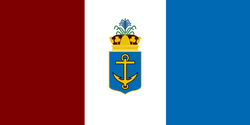 |
| Statistics |
|
| Key topics |
| Provinces |
|
Burgundie portal |
Antilles is part of the Burgoignesc Overseas Territory Assembly's Polar Burgundies geographic designation. Burgoignesc Overseas Territory Assembly is a constituent country equivalent of Burgundie with its own assembly, prime minister, budget, and laws. Burgundie's national governmental influence is limited to subsidies, education, and security, however, its financial and cultural institutes cast a long shadow across Antilles.
Antilles is a province within Burgoignesc Overseas Territory Assembly with its own semi-elected Governor-Epistates, representative legislative body, and court system.
Antillesans are Burgoigniacs/Burgoignix with complete civil and economic rights, and citizenship (political rights) under the same federal service criteria as all residents of Burgundie. Burgoignesc is the official language but Lebhan and Burgoignesc are both in use.
Provincial executive
The provincial executive is the Governor-Epistates. Three candidates are elected by a single transferable vote election held every 5 years, the three candidates are presented to the Court of St. Alphador and the next Governor-Epistates is chosen from these candidates. If the citizenry rejects the selection, a run-off election is held with the remaining two candidates.
Provincial legislature
Like the Citizens Court of the National Assembly (Burg. La Assemblee de Ciutadans de l'Assemblee Nacional, ACAN), The Antillesan Citizen's Court of the Provincial Assembly is a unicameral legislator. It makes provincial law, has the power of the provincial purse, and has the power of impeachment, by which it can remove sitting members of the provincial government. The Assembly has three seats for each province, one for the Burgoignesc Overseas Territory Assembly's Antillesan liaison, 3 for the clergy, 3 seats reserved for municipal leaders, and 3 for a rota of private business leaders. On 6 occasions throughout the year 3 more seats are opened to the public to debate topics that are not on the annual legislative agenda.
Administrative divisions and local governance
Military
Antilles falls under the Navy's Grand Eastern Command, the Army's Middle Seas Command, the Royal Air Service of Burgundie's Audonian Command, and the Vocivine National of Burgundie's Istroyo-Middle Seas Command. Alcairet's strategic location means it is a major military hub for all branches of the Burgoignesc Security Forces with large basing facilities existing for the army (in particular the Burgoignesc Foreign Legion), navy, Royal Air Service, and Vocivine.
Antilles is the home of the GranCom Orientale Admiral's Administrative Department, Rapid Reaction Force GranCom Orientale Command and its Rapid Deployment Group 1 Burg: Groupement Disembarkement Rapide no. 1, Expeditionary Strike Squadron Kandahar Resolve, and Littoral/Riparian Strike Division Riptide. These assets are spread across 3 naval stations, two on Antilles and one on Salarive, Fort Ste. Maude, Fort St. Rouland, and Fort Ste. Jean d'Arche Naval Air Station respectively. The army maintains the III Division, Foreign Legion in Fort Ste. Genvieve on Antilles and the Puhkgundian Gorkha Rifles in Fort St. Reginald on Salarive.
Emergency response
National Gendarmerie of Burgundie, Overseas Gendarmerie, Middle Seas Command
Revenue Guard, Grand Station of the Orient
Society
| This article is part of a series on the |
| Culture in Burgundie |
|---|
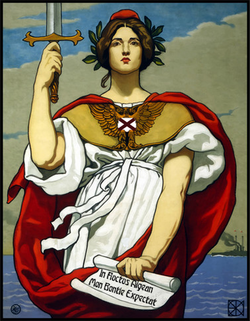 |
| Society |
| Arts and literature |
| Other |
|
Burgundie portal |
Self-reported ethnic origin in Placename (2035)
Antilles is a predominantly Catholic province, a legacy of its Urcean heritage and the Crusader period. However, a significant Protestant minority exists, a result of Gassavelian influence and later Burgoignesc migration. This religious diversity has led to a unique blend of traditions, with both denominations coexisting peacefully and even participating in joint celebrations. Religious festivals, such as Easter and Christmas, are major events in the Antillean calendar, marked by vibrant processions, communal feasts, and religious ceremonies.
Antilleans are a diverse people, shaped by centuries of migration and cultural exchange. The majority are of Audonian descent, with ancestral roots tracing back to the indigenous inhabitants and later Arab settlers. Levantine and later-Burgoignesc influences are also evident, particularly in the island's northern regions. The official languages are Burgoignesc, and Lebhan. Persian remains widely spoken, particularly in rural areas and amongst older generations.
Education in Antilles follows the Burgoignesc system, with a strong emphasis on literacy and critical thinking. Primary and secondary education are mandatory, and the province boasts a high literacy rate. The University of Cruxendale, the island's premier institution of higher learning, offers a wide range of programs in fields such as maritime studies, engineering, and tourism. Additionally, many Antilleans pursue higher education in Burgundie, further strengthening the cultural and academic ties between the two regions. Antilleans are known for their warm hospitality, strong family values, and resilient spirit. Their worldview is shaped by a deep connection to the sea, a legacy of their island heritage and maritime traditions. They are proud of their cultural diversity and open to new ideas, a reflection of their history as a crossroads of civilizations. However, they also value their traditions and customs, which they strive to preserve for future generations. Family is the cornerstone of Antillean society. Extended families often live together, and strong intergenerational bonds are cherished. Elders are respected for their wisdom and experience, and children are raised with a sense of responsibility towards their families and communities. Traditional gender roles are still prevalent, with men often engaged in fishing and seafaring activities, while women manage the household and participate in cottage industries.
Antillean cuisine is a delightful fusion of Levantine and Audonian flavors. Seafood is a staple, with dishes like grilled octopus, fish stew, and stuffed calamari being popular favorites. Other traditional dishes include "pastizzi" (savory pastries filled with ricotta or peas), "lampuki pie" (fish pie), and "imqaret" (date-filled pastries). The use of fresh, local ingredients, along with a blend of aromatic herbs and spices, gives Antillean cuisine its unique and irresistible character.
Antillean art and literature reflect the island's diverse cultural heritage. Traditional crafts like lacemaking, pottery, and filigree jewelry are still practiced, often incorporating local motifs and symbols. Antillean literature, while relatively young, is beginning to emerge, with authors drawing inspiration from the island's history, folklore, and natural beauty. Architecture in Antilles is a blend of various styles, from medieval fortresses and Baroque churches to modern villas and coastal resorts. The traditional Antillean house, with its colorful balconies, internal courtyards, and flat roofs, is a charming reminder of the island's vernacular architecture.
Football (soccer) is the most popular sport in Antilles, with the provincial team participating in national tournaments as well as intermural Audonian leagues. Water sports like sailing, windsurfing, and diving are also popular, taking advantage of the island's beautiful coastline and crystal-clear waters. Traditional Antillean games, such as "bocci" (a form of boules) and "passju" (a card game), are still played in villages and towns.
Antillo-Persians
The Antillo-Persians descend from Persian Gassavelians who, while adhering to Nestorian Christianity, found themselves caught in the religious crossfire of the Protestant Reformation. Their conversion to Protestantism, while initially a matter of survival, led to a deeper embrace of Occidental values and customs. Since the Great Confessional War and the stewardship of the island being remanded to Urcea there have also been a considerable number of conversions to Catholicism.
Antillo-Persians pride themselves on their unique blend of Persian heritage and Western ideals. They have adopted many aspects of Burgoignesc and Levantine culture, including language, dress, and social norms. However, they have also retained certain Persian traditions, such as cuisine, music, and family values, creating a distinctive cultural identity that sets them apart. Their worldview is characterized by a strong work ethic, individualism, and a belief in progress and innovation. They value education and entrepreneurship, and many have achieved success in various fields, including business, medicine, and law. Their strong cultural identity and sense of community have allowed them to thrive in the diverse Antillean society.
The Antillo-Persians' unique position as a Westernized minority within a predominantly Muslim region has presented both challenges and opportunities. They have faced discrimination and prejudice from some segments of society, both in Antilles and in their ancestral homeland of Zaclaria. However, their resilience, adaptability, and strong cultural identity have allowed them to overcome these challenges and carve out a niche for themselves in Antillean society. Their Western outlook and knowledge of Persian culture have also made them valuable intermediaries between Antilles and Zaclaria, facilitating trade and cultural exchange. This has opened up new economic opportunities and strengthened ties between the two regions.
Economy and infrastructure
Fishing, bolstered by the rich marine life of the surrounding waters, stands as a cornerstone. Modern fleets, advanced processing facilities, and a strong export network ensure that Antillean seafood, prized for its quality, reaches global markets. The island's lush rainforests provide another vital resource: tropical timber. Sustainable forestry practices guarantee the longevity of this industry, while the prized mahogany, teak, and rosewood are used in construction, furniture, and shipbuilding worldwide. Antilles has also emerged as a hub for pharmaceutical research and manufacturing. The island's biodiversity, combined with a skilled workforce and favorable policies, has attracted substantial investment. Research centers and facilities focus on innovative treatments, particularly for tropical diseases and natural remedies. Similarly, the unique flora of Antilles fuels a flourishing perfume and cosmetics industry. Skilled artisans and modern laboratories work in tandem to produce exquisite fragrances and beauty products, sought after in luxury markets globally. Agriculture and heavy manufacturing provide additional support to the economy. Fertile soil and a favorable climate allow for the cultivation of citrus fruits, bananas, coffee, and sugarcane, meeting domestic demand and contributing to exports. Meanwhile, a robust heavy manufacturing sector focuses on shipbuilding, steel production, and machinery manufacturing, leveraging the island's strategic location, skilled labor, and access to raw materials. Antillean-made ships are renowned worldwide, while steel and machinery products cater to both domestic and regional needs. Tourism further enriches the economic landscape. The island's natural beauty, cultural heritage, and modern infrastructure draw visitors from around the globe. Pristine beaches, vibrant coral reefs, and historical sites offer a diverse range of experiences, generating significant revenue and employment opportunities. In addition, a thriving services sector, encompassing finance, insurance, telecommunications, and transportation, further bolsters the economy. Antilles' strategic location and infrastructure make it an attractive hub for businesses, enhancing its overall economic vitality.
Standard of living and employment
Because Antilles' economy is a high-low mix of sectors from research to traditional agriculture, opportunities abound for Antilliens at all skill and education levels, which has helped the islands maintain a fairly steady unemployment rate of around X% for the last decade. Burgundie's high emphasis on education translates to a particularly educated and skilled workforce, leading to lower unemployment compared to less educated countries in Audonia. The islands' economic diversity cushions against overreliance on any single industry, which has demonstrably made the island more resilient during downturns. Since Burgundie strives for Total Economic Engagement and espouses equal rights and opportunities regardless of gender, race, ethnicity, ability, or background, Antilles benefits from improved access to education and training, impacting employment prospects across various fields.
Infrastructure
Maritime
Antilles' maritime infrastructure is a testament to its seafaring heritage and strategic importance. The island boasts three well-developed ports, the largest being the bustling Port of Antilles. This state-of-the-art facility features a sprawling container terminal, capable of handling the largest cargo vessels, and comprehensive offloading facilities for diverse cargo types, including break bulk, livestock, roll-on/roll-off (ro-ro), and fuels. The port's modern infrastructure ensures efficient cargo handling and seamless logistics, facilitating trade and commerce. In addition to its cargo operations, the Port of Antilles boasts a dedicated cruise terminal, welcoming a constant stream of tourists from across the globe. The terminal's amenities cater to the needs of cruise passengers, offering comfortable waiting areas, duty-free shops, and convenient transportation links to the island's attractions. This vibrant hub of activity contributes significantly to the island's tourism industry, generating revenue and employment opportunities. Antilles' maritime network extends beyond its shores, connecting the island to regional and international destinations. Two efficient ferries operate between Antilles Maior and Antilles Minor, providing a vital transportation link for residents and visitors alike. These ferries, running hourly, ensure seamless connectivity between the two islands, facilitating trade, tourism, and cultural exchange. Furthermore, Antilles serves as a key transit point for ocean-going ferries connecting Levantia to Audonia. Regular ferry services operate between Antilles and the bustling port cities of Zaclaria, Soirwind, and Alcairet, facilitating the movement of passengers and goods. These ferry routes play a crucial role in regional trade and transportation, linking Antilles to its neighbors and strengthening its position as a maritime hub.
Lighthouses and beacons
There is a Global Maritime Distress and Safety System repeater and beacon on the island.
Rail
Antilles uses Standard gauge, 1,435 mm (4 ft 8+1⁄2 in) for both freight and passenger rail.
Istroyan Rail- Istroyan Rail (Burg: Istroie Ferroviaire), is the public-private joint-venture, intercity, passenger rail operator in Torlen, Antilles, Alcairet, and Chaukhira. It owns and operates all rail corridors, rights of way, and rolling stock that serve this purpose.
Roads
Air
Antilles has one international airport, the St. Michael in the Antilles International Airport, in metro Abu-Ouncanobi.
| Name | Location | Type | Brief description | Code(s) | Picture |
|---|---|---|---|---|---|
| St. Michael in the Antilles International Airport | Passenger and cargo | 24/7/365 air traffic control operations, 1x runway, capable of receiving all but the largest airframes, cargo terminal, passenger terminal, complete maintenance facilities, integrated customs and border control service | ATRO: ANB
ICAO: AANB |
[[|150px|center]] |
Energy and electricity
Phone service and internet
Phone service is provided by Great Seas BurgunMobile, Vintage Wireless, and National Wireless Services, which have 27, 18, and 9 towers respectively across the island. 100% of the island and its population are covered by at least one of the services, National Wireless Services covering the less densely populated and therefore less profitable areas. Copperwire and fiberoptic phone still exists, one or both are required for all municipal and emergency response connections, and people along the route are allowed to buy in, but during emergencies their calls are de-prioritized in favor of emergency response calls, which is the same with mobile service on the island.
Highspeed internet service is provided by Great Seas BurgunMobile, Vintage Wireless, and Extron Burgundie Mobile. Residential internet speeds average 2-3 gigabits while commercial speeds are typically higher in the 3-4 gigabit range.
See also
- Pages using duplicate arguments in template calls
- Incomplete articles
- Pages using infobox settlement with missing country
- Pages using infobox settlement with no coordinates
- Pages using country topics with unknown parameters
- Burgundie
- Sub-national Regions in Burgundie
- Burgundie Problem Articles
- Islands
- Burgoignesc islands








